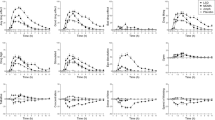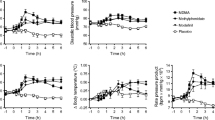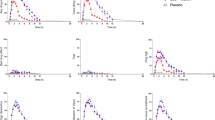Abstract
Rationale
Pupillometry can be used to characterize autonomic drug effects.
Objective
This study was conducted to determine the autonomic effects of 3,4-methylenedioxymethamphetamine (MDMA, ecstasy), administered alone and after pretreatment with reboxetine, duloxetine, clonidine, carvedilol, and doxazosin, on pupillary function.
Methods
Infrared pupillometry was performed in five placebo-controlled randomized studies. Each study included 16 healthy subjects (eight men, eight women) who received placebo–MDMA (125 mg), placebo–placebo, pretreatment–placebo, or pretreatment–MDMA using a crossover design.
Results
MDMA produced mydriasis, prolonged the latency, reduced the response to light, and shortened the recovery time. The impaired reflex response was associated with subjective, cardiostimulant, and hyperthermic drug effects and returned to normal within 6 h after MDMA administration when plasma MDMA levels were still high. Mydriasis was associated with changes in plasma MDMA concentration over time and longer-lasting. Both reboxetine and duloxetine interacted with the effects of MDMA on pupillary function. Clonidine did not significantly reduce the mydriatic effects of MDMA, although it produced miosis when administered alone. Carvedilol and doxazosin did not alter the effects of MDMA on pupillary function.
Conclusions
The MDMA-induced prolongation of the latency to and reduction of light-induced miosis indicate indirect central parasympathetic inhibition, and the faster recovery time reflects an increased sympathomimetic action. Both norepinephrine and serotonin mediate the effects of MDMA on pupillary function. Although mydriasis is lasting and mirrors the plasma concentration–time curve of MDMA, the impairment in the reaction to light is associated with the subjective and other autonomic effects of MDMA and exhibits acute tolerance.





Similar content being viewed by others
References
Anavekar SN, Jarrott B, Toscano M, Louis WJ (1982) Pharmacokinetic and pharmacodynamic studies of oral clonidine in normotensive subjects. Eur J Clin Pharmacol 23:1–5
Benjamin J, Nemetz H, Fux M, Bleichman I, Agam G (1997) Acute inositol does not attenuate m-CPP-induced anxiety, mydriasis and endocrine effects in panic disorder. J Psychiatr Res 31:489–495
Bitsios P, Langley RW, Szabadi E, Bradshaw CM (1996) Comparison of the effects of clonidine on tyramine- and methoxamine-evoked mydriasis in man. Br J Clin Pharmacol 41:269–275
Bitsios P, Szabadi E, Bradshaw CM (1999) Comparison of the effects of venlafaxine, paroxetine and desipramine on the pupillary light reflex in man. Psychopharmacology (Berl) 143:286–292
Chung M, Vashi V, Puente J, Sweeney M, Meredith P (1999) Clinical pharmacokinetics of doxazosin in a controlled-release gastrointestinal therapeutic system (GITS) formulation. Br J Clin Pharmacol 48:678–687
Clifford JM, Day MD, Orwin JM (1982) Reversal of clonidine induced miosis by the α2-adrenoreceptor antagonist RX 781094. Br J Clin Pharmacol 14:99–101
Derogatis LR, Rickels K, Rock AF (1976) The SCL-90 and the MMPI: a step in the validation of a new self-report scale. Br J Psychiatry 128:280–289
Farre M, de la Torre R, Mathuna BO, Roset PN, Peiro AM, Torrens M, Ortuno J, Pujadas M, Cami J (2004) Repeated doses administration of MDMA in humans: pharmacological effects and pharmacokinetics. Psychopharmacology (Berl) 173:364–375
Farre M, Abanades S, Roset PN, Peiro AM, Torrens M, O’Mathuna B, Segura M, de la Torre R (2007) Pharmacological interaction between 3,4-methylenedioxymethamphetamine (ecstasy) and paroxetine: pharmacological effects and pharmacokinetics. J Pharmacol Exp Ther 323:954–962
Heller PH, Perry F, Jewett DL, Levine JD (1990) Autonomic components of the human pupillary light reflex. Invest Ophthalmol Vis Sci 31:156–162
Henderson LS, Tenero DM, Baidoo CA, Campanile AM, Harter AH, Boyle D, Danoff TM (2006) Pharmacokinetic and pharmacodynamic comparison of controlled-release carvedilol and immediate-release carvedilol at steady state in patients with hypertension. Am J Cardiol 98:17L–26L
Hey JA, Gherezghiher T, Koss MC (1988) Atypical α-adrenoceptor mediates phenylephrine-induced mydriasis in anesthetized cats. J Ocul Pharmacol 4:303–310
Hirohashi M, Takasuna K, Tamura K, Yamaguchi K, Maekawa K, Yamada S, Iwasaki S, Yoshida M, Nomura M, Taguchi K (1990) General pharmacological profiles of the new beta-adrenoceptor antagonist carvedilol. Arzneimittelforschung 40:735–746
Hysek CM, Simmler LD, Ineichen M, Grouzmann E, Hoener MC, Brenneisen R, Huwyler J, Liechti ME (2011) The norepinephrine transporter inhibitor reboxetine reduces stimulant effects of MDMA (“ecstasy”) in humans. Clin Pharmacol Ther 90:246–255
Hysek CM, Brugger R, Simmler LD, Bruggisser M, Donzelli M, Grouzmann E, Hoener MC, Liechti ME (2012a) Effects of the α2-adrenergic agonist clonidine on the pharmacodynamics and pharmacokinetics of 3,4-methylenedioxymethamphetamine in healthy volunteers. J Pharmacol Exp Ther 340:286–294
Hysek CM, Domes G, Liechti ME (2012b) MDMA enhances “mind reading” of positive emotions and impairs “mind reading” of negative emotions. Psychopharmacology (Berl). doi:10.1007/s00213-012-2645-9
Hysek CM, Schmid Y, Rickli A, Simmler L, Donzelli M, Grouzmann E, Liechti ME (2012c) Carvedilol inhibits the cardiostimulant and thermogenic effects of MDMA in humans. Br J Pharmacol. doi:10.1111/j.1476-5381.2012.01936.x
Hysek CM, Simmler LD, Nicola VG, Vischer N, Donzelli M, Krähenbühl S, Grouzmann E, Huwyler J, Hoener MC, Liechti ML (2012d) Duloxetine inhibits effects of MDMA (“Ecstasy”) in vitro and in humans in a randomized placebo-controlled laboratory study. PLoS ONE 7(5):e36476. doi:10.1371/journal.pone.0036476
Keranen A, Nykanen S, Taskinen J (1978) Pharmacokinetics and side-effects of clonidine. Eur J Clin Pharmacol 13:97–101
Kolbrich EA, Goodwin RS, Gorelick DA, Hayes RJ, Stein EA, Huestis MA (2008) Physiological and subjective responses to controlled oral 3,4-methylenedioxymethamphetamine administration. J Clin Psychopharmacol 28:432–440
Koss MC, Logan LG, Gherezghiher T (1988) α-Adrenoceptor activation of nictitating membrane and iris in cats. Naunyn Schmiedebergs Arch Pharmacol 337:519–524
Koudas V, Nikolaou A, Hourdaki E, Giakoumaki SG, Roussos P, Bitsios P (2009) Comparison of ketanserin, buspirone and propranolol on arousal, pupil size and autonomic function in healthy volunteers. Psychopharmacology (Berl) 205:1–9
Kramer R, Rubicek M, Turner P (1973) The role of norfenfluramine in fenfluramine-induced mydriasis. J Pharm Pharmacol 25:575–576
Liechti ME, Vollenweider FX (2000) The serotonin uptake inhibitor citalopram reduces acute cardiovascular and vegetative effects of 3,4-methylenedioxymethamphetamine (‘Ecstasy’) in healthy volunteers. J Psychopharmacol 14:269–274
Liechti ME, Vollenweider FX (2001) Which neuroreceptors mediate the subjective effects of MDMA in humans? A summary of mechanistic studies. Hum Psychopharmacol 16:589–598
Liechti ME, Baumann C, Gamma A, Vollenweider FX (2000) Acute psychological effects of 3,4-methylenedioxymethamphetamine (MDMA, “ecstasy”) are attenuated by the serotonin uptake inhibitor citalopram. Neuropsychopharmacology 22:513–521
Liechti ME, Gamma A, Vollenweider FX (2001) Gender differences in the subjective effects of MDMA. Psychopharmacology (Berl) 154:161–168
Loewenfeld IE (1999) The pupil: anatomy, physiology, and clinical applications. Butterworth-Heinemann, Boston
Mas M, Farre M, de la Torre R, Roset PN, Ortuno J, Segura J, Cami J (1999) Cardiovascular and neuroendocrine effects and pharmacokinetics of 3,4-methylenedioxymethamphetamine in humans. J Pharmacol Exp Ther 290:136–145
Mithoefer MC, Wagner MT, Mithoefer AT, Jerome I, Doblin R (2010) The safety and efficacy of ±3,4-methylenedioxymethamphetamine-assisted psychotherapy in subjects with chronic, treatment-resistant posttraumatic stress disorder: the first randomized controlled pilot study. J Psychopharmacol 25:439–452
Morgan T (1994) Clinical pharmacokinetics and pharmacodynamics of carvedilol. Clin Pharmacokinet 26:335–346
Morley MJ, Bradshaw CM, Szabadi E (1991) Effects of clonidine and yohimbine on the pupillary light reflex and carbachol-evoked sweating in healthy volunteers. Br J Clin Pharmacol 31:99–101
Nielsen AG, Pedersen RS, Noehr-Jensen L, Damkier P, Brosen K (2010) Two separate dose-dependent effects of paroxetine: mydriasis and inhibition of tramadol’s O-demethylation via CYP2D6. Eur J Clin Pharmacol 66:655–660
Nieuwenhuis S, van Nieuwpoort IC, Veltman DJ, Drent ML (2007) Effects of the noradrenergic agonist clonidine on temporal and spatial attention. Psychopharmacology (Berl) 193:261–269
Noehr-Jensen L, Zwisler ST, Larsen F, Sindrup SH, Damkier P, Nielsen F, Brosen K (2009) Impact of CYP2C19 phenotypes on escitalopram metabolism and an evaluation of pupillometry as a serotonergic biomarker. Eur J Clin Pharmacol 65:887–894
Phillips MA, Bitsios P, Szabadi E, Bradshaw CM (2000a) Comparison of the antidepressants reboxetine, fluvoxamine and amitriptyline upon spontaneous pupillary fluctuations in healthy human volunteers. Psychopharmacology (Berl) 149:72–76
Phillips MA, Szabadi E, Bradshaw CM (2000b) Comparison of the effects of clonidine and yohimbine on pupillary diameter at different illumination levels. Br J Clin Pharmacol 50:65–68
Phillips MA, Szabadi E, Bradshaw CM (2000c) Comparison of the effects of clonidine and yohimbine on spontaneous pupillary fluctuations in healthy human volunteers. Psychopharmacology (Berl) 150:85–89
Prow MR, Martin KF, Heal DJ (1996) 8-OH-DPAT-induced mydriasis in mice: a pharmacological characterisation. Eur J Pharmacol 317:21–28
Roelands B, Goekint M, Heyman E, Piacentini MF, Watson P, Hasegawa H, Buyse L, Pauwels F, De Schutter G, Meeusen R (2008) Acute norepinephrine reuptake inhibition decreases performance in normal and high ambient temperature. J Appl Physiol 105:206–212
Rothman RB, Baumann MH, Dersch CM, Romero DV, Rice KC, Carroll FI, Partilla JS (2001) Amphetamine-type central nervous system stimulants release norepinephrine more potently than they release dopamine and serotonin. Synapse 39:32–41
Schmitt JA, Riedel WJ, Vuurman EF, Kruizinga M, Ramaekers JG (2002) Modulation of the critical flicker fusion effects of serotonin reuptake inhibitors by concomitant pupillary changes. Psychopharmacology (Berl) 160:381–386
Schmitz N, Hartkamp N, Kiuse J, Franke GH, Reister G, Tress W (2000) The Symptom Check-List-90-R (SCL-90-R): a German validation study. Qual Life Res 9:185–193
Shirai K, Song M, Suzuki J, Kurosu T, Oyama T, Nagayama D, Miyashita Y, Yamamura S, Takahashi M (2010) Contradictory effects of beta1- and alpha1-aderenergic receptor blockers on cardio-ankle vascular stiffness index (CAVI)—CAVI independent of blood pressure. J Atheroscler Thromb 18:49–55
Siepmann T, Ziemssen T, Mueck-Weymann M, Kirch W, Siepmann M (2007) The effects of venlafaxine on autonomic functions in healthy volunteers. J Clin Psychopharmacol 27:687–691
Simmler LD, Hysek CM, Liechti ME (2011) Sex differences in the effects of MDMA (ecstasy) on plasma copeptin in healthy subjects. J Clin Endocrinol Metab 96:2844–2850
Sofuoglu M, Brown S, Babb DA, Pentel PR, Hatsukami DK (2000) Carvedilol affects the physiological and behavioral response to smoked cocaine in humans. Drug Alcohol Depend 60:69–76
Szabadi E, Bradshaw CM (1996) Autonomic pharmacology of α2-adrenoceptors. J Psychopharmacol 10(S3):S6–S18
Tancer M, Johanson CE (2007) The effects of fluoxetine on the subjective and physiological effects of 3,4-methylenedioxymethamphetamine (MDMA) in humans. Psychopharmacology (Berl) 189:565–573
Taylor WR, Chen JW, Meltzer H, Gennarelli TA, Kelbch C, Knowlton S, Richardson J, Lutch MJ, Farin A, Hults KN, Marshall LF (2003) Quantitative pupillometry, a new technology: normative data and preliminary observations in patients with acute head injury: technical note. J Neurosurg 98:205–213
Tham TC, Guy S, McDermott BJ, Shanks RG, Riddell JG (1995) The dose dependency of the alpha- and beta-adrenoceptor antagonist activity of carvedilol in man. Br J Clin Pharmacol 40:19–23
Theofilopoulos N, McDade G, Szabadi E, Bradshaw CM (1995) Effects of reboxetine and desipramine on the kinetics of the pupillary light reflex. Br J Clin Pharmacol 39:251–255
Tomlinson B, Bompart F, Graham BR, Liu JB, Prichard BN (1988) Vasodilating mechanism and response to physiological pressor stimuli of acute doses of carvedilol compared with labetalol, propranolol and hydralazine. Drugs 36(Suppl 6):37–47
Tomlinson B, Prichard BN, Graham BR, Walden RJ (1992) Clinical pharmacology of carvedilol. Clin Investig 70(Suppl 1):S27–S36
Verrico CD, Miller GM, Madras BK (2007) MDMA (ecstasy) and human dopamine, norepinephrine, and serotonin transporters: implications for MDMA-induced neurotoxicity and treatment. Psychopharmacology (Berl) 189:489–503
White TL, Justice AJ, de Wit H (2002) Differential subjective effects of d-amphetamine by gender, hormone levels and menstrual cycle phase. Pharmacol Biochem Behav 73:729–741
Wittchen HU, Wunderlich U, Gruschwitz S, Zaudig M (1997) SKID-I: Strukturiertes Klinisches Interview für DSM-IV. Hogrefe-Verlag, Göttingen
Acknowledgments
We thank Y. Schmid, A. Rickli, A. Fink, R. Brugger, V. Nicola, C. Bläsi, L. Baselgia, S. Müller, and S. Purschke for their assistance in the study management, L. Simmler, M. Donzelli, and R. Brenneisen for the determination of plasma MDMA levels, and M. Arends for the editorial assistance. This work was supported by the Swiss National Science Foundation (grant no. 323230_126231) and University of Basel (grant no. DPH2037).
Conflict of interest
The authors report no biomedical financial interest or potential conflict of interest.
Author information
Authors and Affiliations
Corresponding author
Rights and permissions
About this article
Cite this article
Hysek, C.M., Liechti, M.E. Effects of MDMA alone and after pretreatment with reboxetine, duloxetine, clonidine, carvedilol, and doxazosin on pupillary light reflex. Psychopharmacology 224, 363–376 (2012). https://doi.org/10.1007/s00213-012-2761-6
Received:
Accepted:
Published:
Issue Date:
DOI: https://doi.org/10.1007/s00213-012-2761-6




